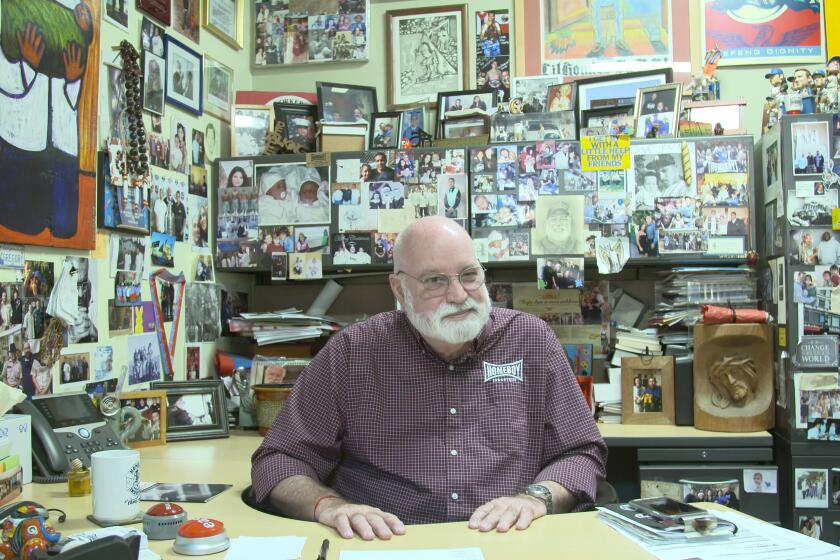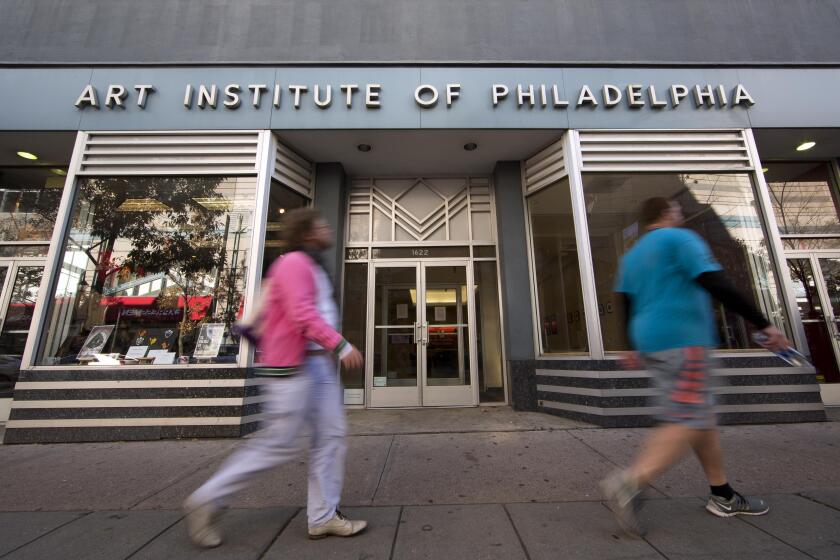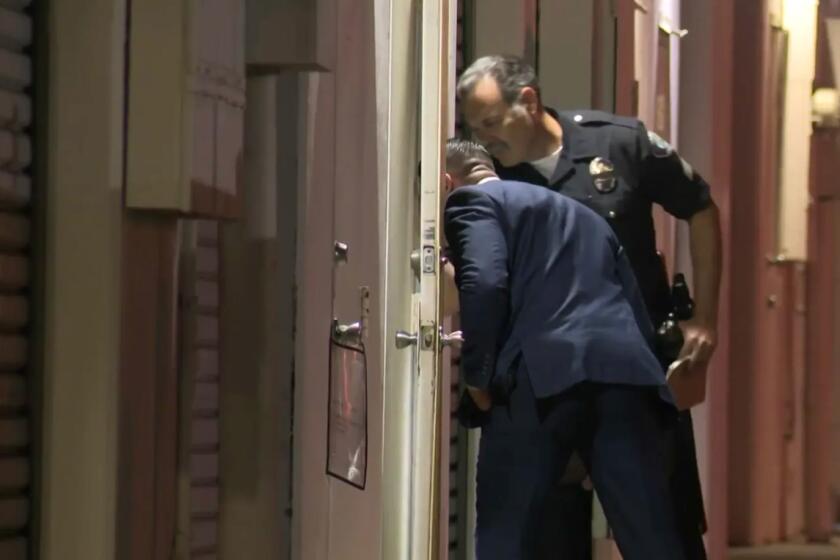White-Collar Crime Boom Challenges FBI
David Lamb came to Los Angeles holding a very special invitation.
The British commodities trader had traveled to several cities in the United States selling millions of dollars worth of bogus tax write-offs created on the London Metal Exchange when he got a promising lead: A group of wealthy taxpayers in Southern California wanted in on the scam.
Several days later, Lamb and colleague Barry Hughes were in Marina del Rey outlining their scheme.
What Lamb and Hughes didn’t know was that the taxpayers were really agents of the Federal Bureau of Investigation who had concealed video cameras to record the meeting as part of an undercover investigation.
The two men were subsequently arrested and last month pleaded guilty to charges that they participated in a scheme to defraud the Internal Revenue Service, which worked alongside the FBI in the investigation. Sentencing is scheduled for Sept. 18.
Just another day in the life of the FBI’s white-collar crime division, which is increasingly using electronic surveillance and undercover operations in an effort to apprehend the thousands of con artists who steal billions of dollars every year from corporations and individuals throughout Los Angeles and Orange counties.
White-collar crime is the FBI’s No. 1 priority in Southern California, an area widely recognized as the capital of financial fraud in the United States. The agency’s fraud division has more computers, electronic gadgets and manpower than any of its agency counterparts, including those fighting the area’s drug and gang activities.
The popular image of the FBI agent was framed in the 1960s by television G-man Efrem Zimbalist Jr., who portrayed agent Lewis Erskine investigating extortionists, communist spies, kidnapers, bank robbers and bomb-wielding radicals in the series, “The FBI.” But the typical FBI agent is as likely to be a lawyer or an accounting wiz poring over documents to investigate a range of sophisticated frauds committed by everyone from buttoned-down banking executives to hard-driving salesmen in boiler room operations.
But the FBI is fighting an uphill battle. There are more scams than agents, and those cases that are investigated often take months to complete.
Fifteen years ago, there were three white-collar crime agents in Orange County and a typical case was a $3,000 bank embezzlement. Today, there are 22 white-collar crime agents in that county and they rarely investigate cases involving less than $1 million.
The FBI does not put a dollar value on its estimate of white-collar crime in Southern California. But consider the fact that the Orange County District Attorney’s Office, which prosecutes only a portion of the white-collar crimes, received fraud complaints totaling about $670 million last year.
“There is a volume of money out here and crooks go where the big money is,” said William Stollhans, assistant special agent in charge of the white-collar crime division in Los Angeles.
Thousands of Ways to Cheat
FBI officials acknowledge that they capture only a fraction of white-collar criminals. The Los Angeles division receives more than 5,000 referrals each year from regulatory agencies and corporations. But last year, that office conducted only about 1,000 investigations.
“We have to pick and choose those cases that are the most egregious and would have the biggest impact,” said Jim Donckels, head of the FBI’s Orange County white-collar crime squad, headquartered in Santa Ana.
The problem is that it takes an agent between nine months and a year on average to complete a fraud investigation. Today’s typical white-collar crime is incredibly complicated and innovative, and investigators must interview scores of people and slog through thousands of pages of documents in search of evidence.
“When you say white-collar crime, it sounds narrow but it’s not. How many ways can you cheat someone? Hundreds of thousands of ways,” said Jim Barko, the fraud instructor at the FBI Academy in Quantico, Va. “There is so much money out there in so many different shapes and forms--commodities, securities, Medicare and Medi-Cal benefits, Social Security--that the temptations are there.”
The FBI has tried to keep up with the increasing sophistication of white-collar criminals by hiring specialists. For instance, nearly 50% of white-collar crime agents in Los Angeles, Ventura and Orange counties are either accountants or attorneys.
Nevertheless, the agents are sometimes outsmarted. “There are many situations . . . where my agent is investigating someone who is more educated than my agent,” Stollhans said.
Keeping good people is increasingly difficult. The starting salary for an agent in Los Angeles and Orange counties is $26,261 a year. After three years, an agent can earn a maximum of $41,121--far less than such a professional can command in the private sector.
As a result, the FBI--which used to be a lifetime commitment for its agents--is now experiencing record turnover. For the first time in its history, more agents resigned last year than retired.
‘They’re Sociopaths’
“Ten years ago, we were somewhat competitive,” said Stollhans. “It’s getting difficult from a pay perspective. In New York, San Francisco and Los Angeles, we are experiencing a retention problem.”
The turnover comes at a time when the typical white-collar crook is better educated and harder to catch than ever. Many have college degrees and no previous criminal record.
“They give to their local churches, live in nice houses, wear nice suits. From all outward appearances, (they are) nice people,” said Donckels. “They don’t think they will get caught. They think they are smarter then you are.”
He thinks that such people undertake their scams for psychological reasons--they’re sociopaths. “It’s not a question of right or wrong. It’s whatever they think they can get away with,” said Donckels.
Of course, the biggest payoff in white-collar crime is the money and many con men spend it lavishly while they are on the take.
Convicted con man Kent Gordon Alexander, for instance, drove a Rolls-Royce paid for in part with the estimated $4 million that he stole from investors while running Newport Investment Management Corp. in Newport Beach in the early 1980s.
Newport Investment took people’s money on the premise that it would invest it for them in gold and silver bars. Instead, the money was spent on overhead and Alexander’s luxurious life style.
‘Successful Look’
Donckels was the agent responsible for going through Alexander’s expenditures during the FBI’s investigation. He found bills for extravagant parties, trips to Hawaii and even a Sears washer and dryer.
“He spent most of it as fast as he got it,” said Donckels. “Most of these people live very extravagantly. I think it’s something unique to white-collar crime. If you are going to have these types of frauds, you have to look successful.”
The FBI doesn’t usually recover any remaining money, leaving that to regulatory agencies to pursue in civil suits.
“Sometimes we find where the money is and seize control of the assets, but that’s rare,” said Donckels.
Because they work hand-in-hand with federal prosecutors, FBI officials were reluctant to talk about the sentences that many white-collar criminals receive--3 1/2 years in Alexander’s case.
But former FBI agents said sentencing is one of the biggest aggravations of the job.
“When you spend more time on a case than a guy ends up getting, it’s a real frustration,” said Tom Andersen, a CPA who left the FBI last year. Andersen now works for a private detective agency in Santa Ana.
But the U.S. Attorney’s Office in Los Angeles said new federal sentencing guidelines have recently resulted in longer prison terms.
Scheme to Dupe Lenders
One reason that punishment for fraud is less severe than some believe it should be is that white-collar cases are so complicated that authorities usually prosecute only a portion of the illegal acts that FBI investigators suspect were committed.
“When we look at an investigation, there is no way on a lot of the big cases we can prove everything that went wrong or look at every violation that is present,” said Donckels.
The Bank of America case, as it has come to be known, is a good example of how complicated things can get and why only a portion of the fraud is ever presented to a jury.
So far, at least 13 Southern Californians have been convicted in connection with a scheme to dupe 22 different lending institutions into paying hundreds of millions of dollars based on fraudulent loan papers filed in the mid-1980s. Bank of America alone estimates that it lost $95 million and the remaining institutions put their collective losses at $500 million.
The FBI has accumulated between 700 and 800 boxes of documents in the case, some of which have been admitted into evidence in the trials of several defendants.
“The hardest thing about these cases is to make them understandable to a jury,” said Donckels.
Unless they are undercover operations, the investigations are principally divided between examining financial documents--which are often obtained through grand jury subpoenas--and talking to eyewitnesses, such as victims and former employees.
Difficult to Prove
The documents are examined for evidence of misappropriated funds and fraud.
“When you see $50,000 to $100,000 going into petty cash, you have to ask yourself why,” said Donckels.
But the witnesses are necessary to prove that the scheme was criminal in its intent and not just bad business.
White-collar crime is difficult to prove and nearly 50% of the FBI’s cases fail to yield indictments. And, of course, indictments do not always result in convictions. The U.S. Attorney’s Office says it does not keep figures on FBI case conviction rates.
“I tell my agents most of the time when they lose a case it’s because they didn’t do their jobs,” said Donckels.
What keeps the agents going is the intellectual challenge of unraveling a fraud.
“This is not like a bank robbery which is just a straight act--someone points a gun and says, ‘Give me your money.’ In white-collar crime, you have to get inside the mind of a thief and find out what he wanted to do and how,” said Donckels. “That’s what is so interesting.”
Several years ago, a federal prosecutor gave Donckels a clock in the form of a Monopoly board, which now hangs over his desk. It reminds him of a trial that followed one of his investigations, when a defendant mused out loud about the game of white-collar crime. “It’s kind of like monopoly,” he said. “We’re going to go around the board as many times as we can before we go to jail.”
WHITE COLLAR CRIME IN SOUTHERN CALIFORNIA
The most prevalent schemes
Bank/savings and loans: Numerous schemes by executives, employees and customers to siphon funds from financial institutions for their own personal use.
Defense procurement: Includes kickbacks from subcontractors to area’s defense giants and cost overruns by prime and subcontractors.
Boiler rooms: Usually telephone solicitations that offer a product or investment but only if victim sends money first. They keep the money and give the victim nothing.
Advance fees: A finder’s fee is charged in return for the promise of the victim getting a loan. The loan is never made.
Insider trading: Company employees or others with access to non-public information profit from trading in the company’s stock.
Major cases in the late 1980s
ZZZZ Best: One-time boy wonder Barry Minkow, who started the Reseda-based carpet cleaning company in his parents’ garage, was convicted in March on 57 counts of fraud and conspiracy. Investors lost tens of millions of dollars.
DEFCON: A probe of defense subcontractors held in conjunction with the Internal Revenue Service and the Defense Criminal Investigative Service. In five years, DEFCON has recovered more than $50 million in fraudulent payments and won more than 100 defense industry convictions.
Bank of America: The San Francisco-based bank and 21 other institutions lost about $500 million in a mortgage loan fraud scheme. Thirteen people convicted to date.
North America Savings & Loan: The biggest case of insider fraud in a California S&L.; Racketeering charges filed against several parties.
Source: Federal Bureau of Investigation
More to Read
Start your day right
Sign up for Essential California for news, features and recommendations from the L.A. Times and beyond in your inbox six days a week.
You may occasionally receive promotional content from the Los Angeles Times.






